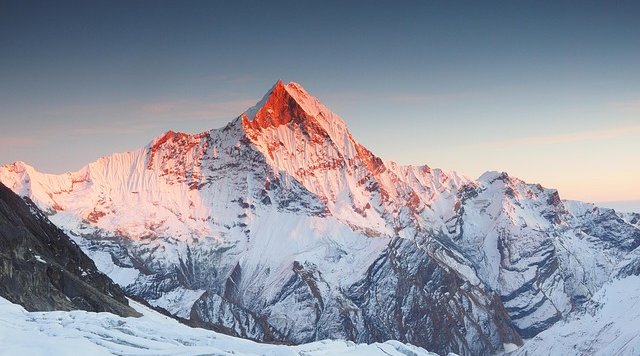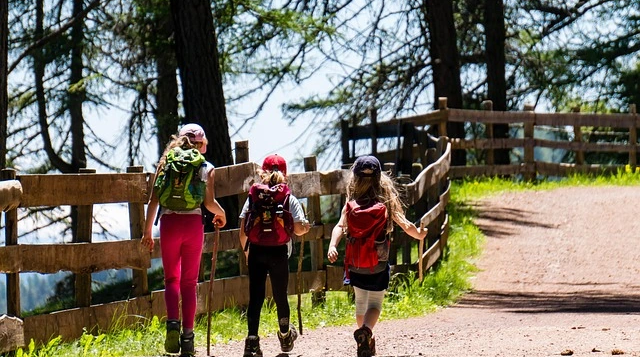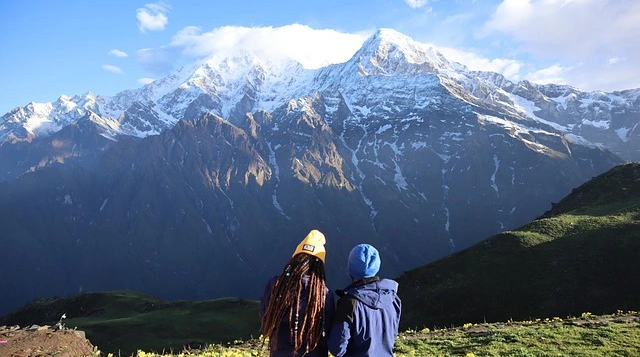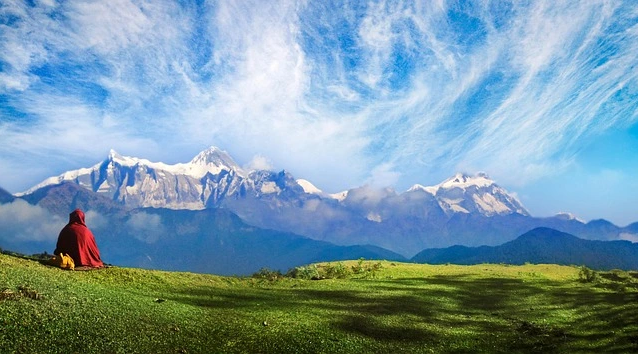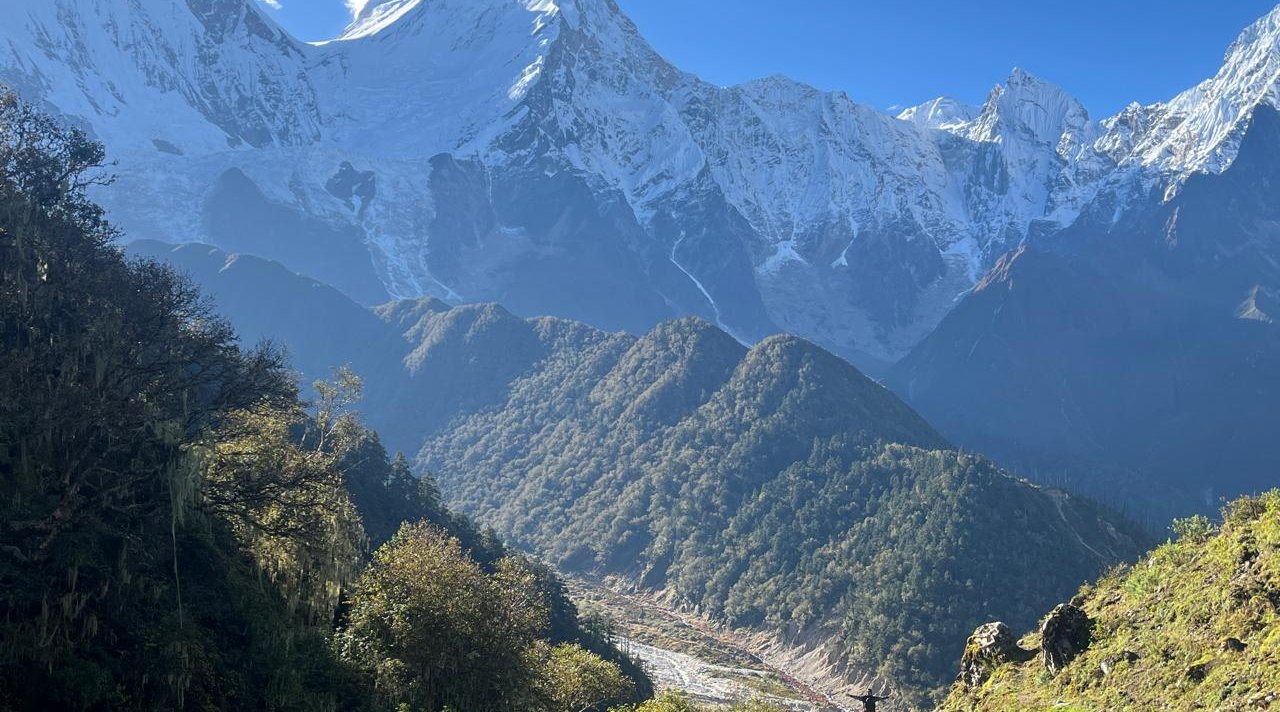The Everest Base Camp vs Annapurna Base Camp trek decision represents Nepal's ultimate trekking dilemma for adventure seekers worldwide. Choosing between EBC vs ABC trek options requires understanding fundamental differences in difficulty, cost, altitude challenges, and the training required EBC vs ABC for successful completion.
This comprehensive EBC vs ABC trek comparison analyzes every critical factor from altitude challenges to cultural immersion, helping Nepal trekking EBC or ABC beginner adventurers make informed decisions. Whether you're drawn to Everest's legendary status at 5,364m or Annapurna's dramatic sanctuary at 4,130m, understanding the Everest Base Camp vs Annapurna Base Camp trek differences in difficulty, cost, duration, and mountain views will guide your decision for this life-changing adventure.
EBC vs ABC Trek: At a Glance Comparison
The Everest Base Camp vs Annapurna Base Camp choice fundamentally depends on your fitness level, budget, and trekking goals. Our detailed EBC vs ABC trek analysis reveals that while both offer world-class mountain experiences, they cater to distinctly different adventure preferences and preparation levels.
Quick Comparison Overview:
Everest Base Camp Trek:
- Max Altitude: 5,364m (17,598ft) - extreme altitude zone
- Standard Duration: 12-14 days for proper acclimatization
- Difficulty Rating: Challenging - requires excellent fitness
- Cost Range (2026): $1,200-2,000 including Lukla flights
- Best Season: March-May and September-November
- Acclimatization Days: 2-3 mandatory rest days required
- Rescue Accessibility: Helicopter-only evacuation
- Cultural Focus: Sherpa Buddhist culture and monasteries
- Signature View: Kala Patthar viewpoint at 5,545m
- Permit Cost: $50 total for tworequired permits
Annapurna Base Camp Trek:
- Max Altitude: 4,130m (13,550ft) - high altitude zone
- Standard Duration: 7-10 days with flexible itinerary
- Difficulty Rating: Moderate - suitable for fit beginners
- Cost Range (2026): $800-1,200 with road transport
- Best Season: March-May and September-December
- Acclimatization Days: 1 optional rest day sufficient
- Rescue Accessibility: Road access below 3,000m plus helicopter
- Cultural Focus: Gurung and Magar villages with mixed religions
- Signature View: 360-degree Annapurna Sanctuary amphitheater
- Permit Cost: $45 total including TIMS card
Difficulty Level: Which Trek is Harder?
The EBC vs ABC difficulty comparison clearly shows Everest Base Camp as the more challenging trek. The combination of higher altitude, longer duration, and greater acute mountain sickness (AMS) risk makes EBC significantly harder than ABC for most trekkers.
Physical Demands and Fitness Requirements: Training Required EBC vs ABC
Understanding which is harder EBC or ABC starts with analyzing the physical demands and training required EBC vs ABC preparation. The Everest Base Camp vs Annapurna Base Camp trek fitness requirements differ significantly, with EBC requiring excellent cardiovascular fitness to handle 5-7 hours of daily trekking at extreme altitude, while ABC's lower elevation allows moderate fitness levels to succeed.
EBC Physical Requirements and Training Program:
- Training required EBC vs ABC: EBC needs 3-4 months of dedicated cardio and strength training vs ABC's 6-8 weeks
- Daily hiking demands: 5-7 hours on rocky, steep terrain tests your EBC vs ABC preparation levels
- Altitude impact on performance: Reduced oxygen makes every step harder above 4,000m on EBC trek
- Energy expenditure: Burns 4,000-5,000 calories daily requiring substantial Nepal trekking EBC or ABC beginner nutrition planning
- Recovery challenges: Slower muscle recovery at altitude affects your EBC vs ABC trek pace
- Specific training required EBC vs ABC: Stair climbing with weighted pack essential for Everest preparation
ABC Physical Requirements and Training Needs:
- Training required EBC vs ABC: ABC needs only 6-8 weeks of regular hiking preparation for Nepal trekking EBC or ABC beginner success
- Daily hiking on ABC: 4-6 hours on varied terrain including stone steps throughout your trek
- Altitude impact comparison: Noticeable but manageable below 4,200m making ABC easier than EBC
- Energy needs: Burns 3,000-4,000 calories daily on your Everest Base Camp vs Annapurna Base Camp trek choice
- Recovery advantages: Normal recovery rates throughout ABC trek unlike EBC's altitude challenges
- Beginner-friendly training: Regular walking and gym cardio sufficient for ABC vs EBC's intense preparation needs
Altitude Challenges and Acclimatization Needs
The EBC vs ABC difficulty gap widens significantly when comparing altitude challenges. EBC's journey above 5,000m enters the extreme altitude zone where only 50% oxygen availability challenges even fit trekkers.
Altitude Comparison:
- EBC altitude progression: Lukla (2,860m) → Namche Bazaar (3,440m) → Tengboche (3,860m) → Dingboche (4,410m) → Lobuche (4,940m) → EBC (5,364m)
- ABC altitude progression: Nayapul (1,070m) → Ghorepani (2,860m) → Tadapani (2,630m) → Deurali (3,230m) → ABC (4,130m)
- Acclimatization days: EBC requires 2-3 mandatory rest days vs ABC's optional single day
- AMS risk: 40-50% on EBC vs 15-20% on ABC
- Emergency descent: EBC's remote location complicates evacuation vs ABC's accessible routes
Technical Difficulty Assessment
Featured Snippet Answer: EBC is harder than ABC due to higher altitude (5,364m vs 4,130m), longer duration (14 vs 10 days), and greater altitude sickness risk. ABC at 4,130m has lower risk and shorter commitment. EBC requires good fitness and high-altitude experience, while ABC is suitable for motivated beginners with basic fitness.
Cost Comparison: EBC vs ABC Budget Breakdown
The EBC vs ABC cost difference averages $400-800, with Everest Base Camp requiring a significantly higher budget primarily due to expensive Lukla flights. Understanding the complete budget comparison EBC ABC 2026 helps trekkers plan finances accurately.
Transportation Costs: Lukla Flights vs Pokhara Access
The Lukla flights vs Pokhara drive cost represents the largest single expense difference between treks. EBC's dependency on weather-sensitive flights adds both cost and uncertainty to your budget.
Transportation Breakdown:
- EBC transportation: $400-480 for round-trip Lukla flights from Kathmandu
- ABC transportation: $30-50 for tourist bus or $150 for private vehicle to Pokhara
- Flight reliability: 30% chance of Lukla delays requiring hotel stays
- Alternative EBC road: 4-day trek from Jiri saves $350 but adds time
- ABC flexibility: Multiple road access points offer budget options
Daily Expenses and Accommodation Costs
Teahouse accommodation costs vary significantly between routes, with EBC commanding premium prices at altitude. The teahouse quality EBC vs ABC comparison shows similar facilities but different pricing structures.
Daily Cost Comparison:
EBC Daily Expenses:
- Accommodation: $5-20 (increases with altitude)
- Breakfast: $5-10 for set meals with eggs and toast
- Lunch: $7-12 for noodles or fried rice
- Dinner: $8-15 for Dal Bhat or mixed dishes
- Water/Drinks: $3-5 per liter at higher camps
- Wi-Fi/Charging: $3-5 combined daily expense
- Total Daily Budget: $31-67 depending on altitude
ABC Daily Expenses:
- Accommodation: $3-10 (modest increase with altitude)
- Breakfast: $4-7 for basic set breakfast
- Lunch: $5-8 for standard meal options
- Dinner: $6-10 for hearty evening meals
- Water/Drinks: $2-4 throughout the trek
- Wi-Fi/Charging: $2-3 when available
- Total Daily Budget: $22-42 more consistent pricing
Hidden Costs and Budget Tips
Budget trekking EBC vs ABC requires understanding hidden expenses that inflate final costs. Both treks include unexpected charges that catch unprepared trekkers off-guard.
Hidden Costs to Budget:
- Tips for guides/porters: $100-150 (EBC) vs $60-80 (ABC)
- Hot showers: $3-5 per shower at altitude
- Device charging: $2-5 per charge above 3,500m
- Snacks and treats: Prices triple at altitude
- High altitude insurance: $150-200 mandatory for both
- Emergency fund: $300-500 recommended for evacuations
- Gear rental/purchase: $100-200 if not fully equipped
Duration and Itinerary: Time Investment Analysis
The EBC vs ABC duration difference of 4-7 days significantly impacts planning, with 14 days EBC vs 10 days ABC representing standard itineraries. This time investment affects everything from vacation planning to physical preparation requirements.
Standard Trek Lengths and Variations
Standard durations reflect optimal acclimatization and enjoyment pace. Rushed itineraries increase altitude sickness risk and diminish the trekking experience quality.
EBC Duration Options:
- 10-day speed trek: High AMS risk, requires excellent fitness
- 12-day standard: Balanced pace with basic acclimatization
- 14-day recommended: Proper acclimatization with side trips
- 16-day relaxed: Includes Gokyo Lakes or extra rest days
- Return options: 3-4 days descent or $500 helicopter flight
ABC Duration Options:
- 7-day rapid: Direct route, minimal exploration
- 10-day standard: Includes Poon Hill sunrise view
- 12-day extended: Adds Mardi Himal or hot springs
- 14-day comprehensive: Combines with Ghorepani circuit
- Flexible exit: Multiple road access points allow customization
Acclimatization Schedule Differences
Acclimatization days represent non-negotiable safety requirements on EBC while remaining optional for ABC. This schedule difference impacts both duration and difficulty significantly.
Acclimatization Comparison:
- EBC mandatory stops: Namche Bazaar (2 nights) and Dingboche (2 nights)
- ABC flexible approach: Optional rest day at Machapuchare Base Camp
- Altitude gain rules: EBC limits to 300-500m daily above 3,000m
- ABC progression: Can safely gain 500-700m daily
- Side trip options: EBC uses rest days for Everest View Hotel or Chhukung Valley
- ABC alternatives: Rest days allow Annapurna South Base Camp exploration
Scenery and Views: Mountain Panoramas Compared
The EBC vs ABC views debate centers on Everest's iconic status versus Annapurna's dramatic amphitheater. Both offer world-class mountain scenery, but the viewing experiences differ dramatically in character and accessibility.
Peak Visibility and Photography Opportunities
Comparing Kala Patthar vs Annapurna Base Camp views reveals distinct advantages for each trek. Weather patterns and viewpoint accessibility affect photography success rates differently on each route.
EBC Viewpoint Highlights:
- Kala Patthar (5,545m): Everest's best view requires extra climb from Gorak Shep
- Everest visibility: Only 60% clear view chance even in peak season
- Supporting peaks: Lhotse, Nuptse, Ama Dablam, and Pumori dominate skyline
- Khumbu Glacier: World's highest glacier creates dramatic foreground
- Sunrise shots: 4am start required for golden hour at Kala Patthar
- Prayer flags: Colorful Buddhist symbols frame mountain views
ABC Viewpoint Highlights:
- Annapurna Sanctuary: 360-degree amphitheater of peaks from base camp
- Machapuchare (Fishtail): Sacred unclimbed peak dominates southern view
- Dawn patrol: Sunrise directly illuminates Annapurna I from camp
- Avalanche viewing: Safe distance to witness ice falls on Annapurna South
- Rhododendron forests: Spring blooms create colorful foregrounds below 3,000m
- Clear weather: 70-80% visibility in peak season
Signature Viewpoints and Photo Spots
Each trek offers Instagram-worthy locations beyond the main objectives. Understanding these photography hotspots helps maximize your visual memories.
EBC Photography Locations:
- Tengboche Monastery: Ama Dablam backdrop with Buddhist architecture
- Everest View Hotel: World's highest hotel terrace at 3,880m
- Dudh Koshi River: Turquoise glacial waters with suspension bridges
- Namche Bazaar: Amphitheater setting with Kongde Ri walls
- Pangboche: Ancient monastery with yeti scalp legend
ABC Photography Locations:
- Poon Hill: Dhaulagiri to Manaslu panorama at sunrise
- Gurung villages: Traditional stone houses with mountain backdrops
- Modi Khola valley: Deep gorge approach to sanctuary
- Hinku Cave: Dramatic overhang shelter with valley views
- Deurali: Last viewpoint before entering sanctuary
Accessibility and Transportation
The EBC vs ABC accessibility comparison heavily favors Annapurna for flexibility and emergency options. Understanding transportation logistics prevents costly surprises and safety concerns during your trek.
Getting There: Flight Dependencies vs Road Options
Lukla flights vs Pokhara drive represents a fundamental difference affecting cost, reliability, and trek flexibility. Weather dependencies create distinct planning challenges for each route.
EBC Access Challenges:
- Tenzing-Hillary Airport: World's most dangerous airport with 30% cancellation rate
- Weather windows: Only morning flights due to afternoon clouds
- Kathmandu delays: Average 1-2 buffer days needed for weather
- Alternative routes: Jiri road approach adds 4-5 days each way
- Helicopter backup: $3,000+ for emergency chartered flights
- Seasonal closures: Monsoon makes flights extremely unreliable
ABC Access Advantages:
- Pokhara gateway: Tourist hub with restaurants and lakeside relaxation
- Multiple entry points: Nayapul, Ghandruk, or Kimche access options
- Road reliability: Year-round access regardless of weather
- Public transport: Frequent buses reduce costs to $5-10
- Exit flexibility: Can finish at different points than start
- Airport option: Pokhara flights available for time-conscious trekkers
Emergency Evacuation Considerations
Rescue options EBC vs ABC differ dramatically in speed, cost, and availability. Understanding evacuation procedures could save your life in emergencies.
Emergency Protocols Comparison:
- EBC evacuation: Helicopter-only rescue costing $4,000-6,000
- ABC evacuation: Road ambulance below 3,000m, helicopter above
- Response time: EBC averages 2-6 hours vs ABC's 1-3 hours
- Insurance requirements: Both need high-altitude coverage to 6,000m
- Communication: EBC relies on satellite phones vs ABC's mobile coverage
- Hospital access: EBC requires Kathmandu flight vs ABC's Pokhara proximity
Cultural Experience: Sherpa vs Gurung Traditions
The Sherpa culture vs Gurung villages comparison reveals distinct ethnographic experiences. EBC vs ABC culture differences offer unique insights into Nepal's diverse mountain communities and their adaptation to extreme environments.
Local Communities and Ethnic Diversity
Each trek immerses you in different Himalayan cultures with unique traditions, languages, and lifestyles. The cultural authenticity remains strong despite tourism influence on both routes.
EBC Sherpa Culture:
- Buddhist influence: Prayer wheels, mani walls, and stupas line trails
- Namche Bazaar: Traditional trading hub turned trekking capital
- Yak herding: Traditional livestock adapted to high altitude
- Climbing heritage: Home to Everest summiteers and expedition support
- Saturday market: Weekly gathering maintains trading traditions
- Tibetan influence: Architecture and cuisine reflect border proximity
ABC Gurung Villages:
- Hindu-Buddhist blend: Mixed religious practices and festivals
- Ghandruk village: Traditional stone architecture preserved
- Honey hunting: Ancient cliff honey collection traditions
- Military heritage: Gurkha soldier recruitment legacy
- Agricultural terraces: Subsistence farming below 3,000m
- Cultural museums: Village exhibits preserve traditional lifestyles
Monastery Visits and Spiritual Sites
Spiritual experiences differ between routes, with EBC offering active Buddhist monasteries while ABC features diverse religious sites. Both provide insights into mountain spirituality and religious adaptation.
EBC Spiritual Highlights:
- Tengboche Monastery: Khumbu's spiritual center with daily prayers
- Pangboche Gompa: Oldest monastery claiming yeti scalp relic
- Prayer flag ceremonies: Participate in traditional blessing rituals
- Mani stones: Sacred carved tablets line entire trail
- Buddhist festivals: Mani Rimdu celebration if timing aligns
- Meditation opportunities: Monastery guesthouses offer programs
ABC Spiritual Diversity:
- Hindu shrines: Dedicated to Annapurna goddess of harvest
- Buddhist stupas: Mark sacred sanctuary entrance
- Natural temples: Caves and springs hold religious significance
- Village temples: Active worship sites in Gurung communities
- Festival celebrations: Dashain and Tihar if trekking in autumn
- Shamanic traditions: Local healers maintain ancient practices
Best Time to Trek: Seasonal Considerations
The EBC vs ABC best time analysis reveals different optimal windows due to altitude and weather patterns. Understanding season comparison EBC vs ABC helps maximize clear views while avoiding crowds and extreme conditions.
Peak Season Crowds and Weather
Peak season EBC vs ABC timing affects everything from accommodation availability to trail congestion. Weather windows determine mountain visibility and trekking comfort levels.
Peak Season Comparison:
- EBC peak (March-May): 300-400 daily trekkers create bottlenecks
- ABC peak (March-April): 200-300 daily trekkers but spread across routes
- Autumn crowds (Sept-Nov): Both experience maximum traffic
- Accommodation pressure: EBC requires advance booking vs ABC flexibility
- Weather reliability: 70% clear days in peak vs 40% off-season
- Temperature ranges: EBC (-15°C to 15°C) vs ABC (-5°C to 20°C)
Month-by-Month Comparison
Weather comparison EBC vs ABC throughout the year reveals distinct trekking windows. Each month offers unique advantages and challenges for both routes.
Monthly Seasonal Breakdown:
January:
- EBC Conditions: Very cold (-20°C), crystal clear views, empty trails
- ABC Conditions: Cold nights (-10°C), clear skies, minimal crowds
February:
- EBC Conditions: Cold improving gradually, excellent visibility begins
- ABC Conditions: Warming temperatures, rhododendrons starting to bloom
March:
- EBC Conditions: Peak season begins, perfect weather, crowds building
- ABC Conditions: Ideal conditions emerge, flowers blooming, increasing traffic
April:
- EBC Conditions: Crowded but clear skies, warmer temperatures daily
- ABC Conditions: Best month overall, full bloom season, busy trails
May:
- EBC Conditions: Pre-monsoon clouds appearing, warm days, summit season
- ABC Conditions: Getting cloudy afternoons, still good trekking mornings
June:
- EBC Conditions: Monsoon starts, avoid trekking, lodges closing
- ABC Conditions: Rainy season begins, leeches appear, limited views
July:
- EBC Conditions: Heavy rain throughout, trails dangerous, not recommended
- ABC Conditions: Monsoon peak period, extremely wet, avoid trekking
August:
- EBC Conditions: Monsoon continuing heavily, closed lodges, no flights
- ABC Conditions: Rain decreasing gradually, trails muddy, few trekkers
September:
- EBC Conditions: Clearing skies beautifully, trails recovering, reopening season
- ABC Conditions: Post-monsoon clarity emerging, excellent views returning
October:
- EBC Conditions: Perfect conditions throughout, very crowded trails, book ahead
- ABC Conditions: Ideal weather returns, peak season crowds, clear mountains
November:
- EBC Conditions: Clear but cooling rapidly, still busy, last good month
- ABC Conditions: Great visibility continues, comfortable temperatures, busy trails
December:
- EBC Conditions: Cold but clear days, fewer trekkers, peaceful experience
- ABC Conditions: Cold nights arriving, sunny days persist, quiet trails
Which Trek is Right for You?
The EBC vs ABC for beginners question depends on fitness, experience, and personal goals. Understanding which suits first time trekking EBC or ABC requires honest self-assessment of capabilities and expectations.
Beginner Recommendations
Nepal trekking EBC or ABC beginner choices should prioritize safety and enjoyment over ambition. ABC generally suits beginners better due to lower altitude and shorter duration.
ABC for Beginners - Advantages:
- Lower altitude risk: 4,130m maximum reduces AMS concerns
- Shorter commitment: 7-10 days fits most vacation schedules
- Gradual ascent: Better acclimatization profile for novices
- Multiple exit points: Flexibility if problems arise
- Budget-friendly: Lower costs reduce financial pressure
- Road access: No flight anxiety or weather delays
EBC for Beginners - Requirements:
- Prior experience: Previous trekking above 3,000m recommended
- Extended training: 3-4 months preparation minimum
- Time availability: 16-18 days including buffer
- Higher budget: $1,500+ for proper support
- Mental preparation: Commitment to challenging conditions
- Group support: First-timers should avoid solo trekking
Experience Level Requirements
Training required EBC vs ABC varies significantly based on current fitness and trekking background. Honest assessment prevents disappointment and dangerous situations.
Ideal Candidate Profiles:
EBC Ideal Trekker:
- Previous experience: Completed multi-day hikes above 3,000m
- Fitness level: Can hike 6 hours with 10kg pack
- Age consideration: 16-65 years with good health
- Time availability: 2-3 weeks vacation possible
- Budget range: $1,500-2,500 comfortable spending
- Motivation: Everest dream worth extra challenge
ABC Ideal Trekker:
- Experience needs: Basic hiking experience sufficient
- Fitness level: Regular walking/hiking 3-4 hours
- Age range: 12-70 years with moderate health
- Time requirement: 10-14 days including travel
- Budget range: $800-1,500 reasonable investment
- Goals: Mountain experience without extreme challenge
Solo Female Trekking: Safety Comparison
Solo female trekking EBC vs ABC presents different safety considerations and cultural dynamics. Both routes are generally safe with proper precautions, but ABC offers slightly more comfort for solo female travelers.
Safety Factors Comparison:
- Trail traffic: EBC's busier trails provide more security through numbers
- Guide availability: Female guides more common on ABC route
- Accommodation: ABC offers more private room options at lower cost
- Cultural comfort: Both regions respect female trekkers
- Communication: ABC has better mobile coverage for emergencies
- Group formation: Easy to join others on both routes at starting points
Solo Female Tips:
- Book female guides: Available through specialized agencies
- Join women's groups: Facebook groups connect female trekkers
- Dress modestly: Respect local customs in villages
- Trust instincts: Change lodges if uncomfortable
- Stay connected: Rent satellite phone for EBC, use mobile on ABC
- Insurance priority: Comprehensive coverage with evacuation essential
Equipment and Packing Considerations: EBC vs ABC Trek Gear Requirements
The packing list EBC vs ABC differs significantly in cold weather gear requirements, affecting both your Everest Base Camp vs Annapurna Base Camp trek budget and luggage weight. Understanding equipment needs for EBC vs ABC trek preparation prevents expensive last-minute purchases or uncomfortable trekking conditions that could ruin your adventure.
Essential Gear Differences for EBC vs ABC:
- Sleeping bag rating: EBC needs -20°C for extreme cold vs ABC -10°C sufficient for moderate altitude
- Down jacket weight: EBC vs ABC requirement shows expedition-weight needed for Everest vs mid-weight for Annapurna
- Base layers needed: EBC requires 3-4 thermal sets vs ABC needs only 2 sets for temperature variation
- Gloves comparison: EBC demands liner plus insulated gloves vs ABC single pair adequate for most conditions
- Boot requirements: EBC vs ABC footwear shows 4-season boots benefit Everest vs 3-season sufficient for Annapurna
- Daypack capacity: Both EBC and ABC need 30-40L for layers, water, and camera equipment
Rental vs Purchase Decision for EBC vs ABC Trek:
- Kathmandu rental costs: Full gear set $10-15/day works for either Everest Base Camp vs Annapurna Base Camp trek
- Quality concerns: Rental gear often worn but functional for both EBC and ABC requirements
- Purchase priorities: Boots, base layers, and personal items essential for both treks
- ABC advantage: Lighter gear requirements reduce overall packing list EBC vs ABC costs significantly
- EBC consideration: Extreme cold gear worth purchasing if planning future high-altitude treks
- Budget impact: EBC vs ABC gear costs differ by $200-400 depending on rental vs purchase decisions
Permits and Regulations: EBC vs ABC Trek Requirements
The permit cost EBC vs ABC shows minimal difference at $50 vs $45, but understanding guide requirement EBC vs ABC regulations helps avoid legal issues on your Everest Base Camp vs Annapurna Base Camp trek. Both regions require proper documentation, but the EBC vs ABC trek permit process differs in complexity and future regulatory changes.
EBC Permits ($50 total) - Everest Base Camp vs Annapurna Base
Camp Documentation:
- Sagarmatha National Park: $30 (NPR 3,000) entry fee required for all EBC trekkers
- Khumbu Local Permit: $20 (NPR 2,000) municipality fee supporting local development
- TIMS elimination: No longer required for EBC as of 2023, simplifying permits
- Guide requirement EBC vs ABC: Mandatory guide policy for EBC under government consideration
- Processing locations: Available in Kathmandu or Monjo for EBC vs ABC convenience
- Validity period: Single entry only, plan your EBC vs ABC itinerary accordingly
ABC Permits ($45 total) - Annapurna Base Camp Requirements:
- Annapurna Conservation Area: $30 (NPR 3,000) entry supporting conservation
- TIMS Card requirement: $15 for independent trekkers, different from EBC regulations
- Guide requirement EBC vs ABC: ABC remains optional but recommended for safety
- Processing flexibility: Kathmandu or Pokhara offices serve ABC trekkers
- Permit validity: Single entry, non-transferable like EBC permits
- Future changes: ABC likely to maintain current flexible guide policies unlike EBC
Food and Dining Experience: EBC vs ABC Trek Cuisine
The food quality EBC vs ABC teahouses comparison reveals similar menus but significant differences in freshness, variety, and pricing throughout your Everest Base Camp vs Annapurna Base Camp trek. Understanding food quality EBC vs ABC teahouses helps budget accurately while Dal Bhat meals remain the best value on both EBC vs ABC routes, providing unlimited refills and balanced nutrition.
Dining Experience Comparison for EBC vs ABC Trek:
- Menu variety: ABC offers more fresh vegetables due to lower altitude vs EBC's limited options
- Price progression: EBC vs ABC cost shows Everest prices double by base camp vs Annapurna's 50% increase
- Local specialties: EBC features yak cheese and meat vs ABC's buffalo products and fresh dairy
- Western food availability: Both EBC and ABC offer pasta and pizza, but food quality EBC vs ABC teahouses varies significantly
- Dietary restrictions: Vegetarian easy on both treks, vegan possible with advance planning for EBC or ABC
- Water safety: Both Everest Base Camp vs Annapurna Base Camp require purification tablets or bottled water
Typical Meal Costs Comparison:
Dal Bhat (Traditional Meal with Unlimited Refills):
- EBC Cost Range: $4-12 depending on altitude
- ABC Cost Range: $3-8 throughout trek
Breakfast Set (Eggs, Toast, Hash Browns):
- EBC Cost Range: $5-10 increasing with elevation
- ABC Cost Range: $4-7 relatively stable pricing
Noodle Soup (Thukpa or Ramen):
- EBC Cost Range: $4-10 comfort food at altitude
- ABC Cost Range: $3-7 affordable throughout
Fried Rice or Chow Mein:
- EBC Cost Range: $5-11 popular carb-loading option
- ABC Cost Range: $4-8 consistent pricing
Pizza (Where Available):
- EBC Cost Range: $8-15 luxury item at altitude
- ABC Cost Range: $6-10 occasional treat
Beer (600ml Bottle):
- EBC Cost Range: $5-10 doubles at base camp
- ABC Cost Range: $4-7 moderate increase only
Tea/Coffee per Cup:
- EBC Cost Range: $2-5 essential morning warmth
- ABC Cost Range: $1-3 reasonable throughout
Health and Medical Considerations
Understanding rescue options EBC vs ABC and medical facility access helps prepare for health challenges. Acute mountain sickness (AMS) risk differs significantly between routes due to altitude profiles.
Health Risk Comparison:
- AMS incidence: EBC 40-50% vs ABC 15-20% of trekkers
- Severe altitude illness: EBC 2-3% HACE/HAPE vs ABC <1%
- Gastrointestinal issues: Equal risk on both routes (20-30%)
- Injury rates: Similar slip/fall risks, weather dependent
- Hypothermia risk: EBC significant above 5,000m vs ABC minimal
- Medical facilities: EBC has HRA clinic in Pheriche vs ABC basic health posts
Prevention Strategies:
- Acclimatization: Follow "climb high, sleep low" principle
- Hydration: 3-4 liters daily minimum at altitude
- Diamox consideration: Prophylactic use debated, consult doctor
- Recognition: Know AMS symptoms - headache, nausea, fatigue
- Descent protocol: Immediate descent if symptoms worsen
- Insurance verification: Confirm helicopter evacuation coverage
Environmental Impact and Sustainability: EBC vs ABC Trek Conservation
Both Everest Base Camp vs Annapurna Base Camp treks face environmental challenges from increasing tourism affecting the pristine Himalayan ecosystem. Understanding your impact on EBC vs ABC trek routes helps preserve these regions for future generations while supporting local communities through responsible Nepal trekking EBC or ABC beginner practices.
Sustainability Comparison for Everest Base Camp vs Annapurna Base Camp:
- Waste management crisis: EBC struggles with volume due to remote location vs ABC's better infrastructure access
- Deforestation concerns: Both EBC and ABC regions ban wood fires above certain altitudes for conservation
- Trail erosion patterns: EBC's fragile alpine ecosystem vs ABC's monsoon damage creates different challenges
- Water contamination: Both EBC vs ABC trek routes face risks from poor sanitation practices
- Porter welfare standards: EBC has stronger porter unions vs ABC's more informal arrangements affecting fair treatment
- Carbon footprint comparison: EBC vs ABC shows Lukla flights add significant emissions vs ABC's road access advantage
Responsible Trekking Practices for EBC vs ABC:
- Waste reduction: Carry out all non-biodegradable items from both Everest Base Camp vs Annapurna Base Camp treks
- Support local economy: Choose locally-owned teahouses on your EBC vs ABC trek for community benefit
- Wildlife protection: Maintain safe distance from animals in both EBC and ABC conservation areas
- Cultural sensitivity: Ask permission before photographing people on either EBC or ABC route
- Fair porter wages: Ensure appropriate compensation regardless of EBC vs ABC trek choice
- Leave no trace: Follow international wilderness principles on your Nepal trekking EBC or ABC beginner adventure
Frequently Asked Questions
Which is harder: EBC or ABC trek?
EBC is significantly harder than ABC due to higher altitude (5,364m vs 4,130m), longer duration (14 vs 10 days), and greater altitude sickness risk. ABC suits beginners while EBC requires good fitness and preferably high-altitude experience.
What's the cost difference between EBC and ABC treks?
EBC costs $1,200-2,000 while ABC runs $800-1,200 for standard packages. The main difference is Lukla flights ($400+) for EBC versus road transport ($30-150) for ABC. Daily expenses are also 20-30% higher on EBC.
How long does each trek take?
EBC typically requires 12-14 days for proper acclimatization, while ABC takes 7-10 days standard. Including travel time from Kathmandu, budget 16-18 days for EBC and 10-14 days for ABC.
Which trek is better for beginners considering Nepal trekking EBC or ABC beginner requirements?
ABC is significantly better for beginners due to lower altitude (4,130m), shorter duration (7-10 days), and gradual ascent profile. The Nepal trekking EBC or ABC beginner choice clearly favors ABC as it requires less training, has lower AMS risk, and offers multiple exit points for safety, while EBC demands extensive preparation and altitude experience.
What's the best time to do EBC vs ABC?
Both share optimal seasons: March-May (spring) and September-November (autumn). ABC has a slightly longer window (September-December) due to lower altitude. Avoid June-August monsoon for both.
Which has better mountain views?
Both offer world-class views but differently. EBC provides iconic Everest views from Kala Patthar plus Ama Dablam and Lhotse. ABC offers a 360-degree amphitheater with Annapurna I, Machapuchare, and Dhaulagiri.
Is solo female trekking safe on both routes?
Yes, both routes are generally safe for solo female trekkers with proper precautions. ABC offers slightly better infrastructure and communication. Join groups at starting points, hire reputable guides, and maintain cultural sensitivity.
What about altitude sickness risk on Everest Base Camp vs Annapurna Base Camp trek?
EBC has 40-50% AMS incidence versus ABC's 15-20% due to higher altitude and rapid ascent from Lukla (2,860m). The EBC vs ABC difficulty comparison shows ABC's gradual ascent from 1,070m provides better natural acclimatization, making it safer for those concerned about altitude sickness on their Nepal trekking EBC or ABC beginner adventure.
Which trek offers better cultural experience?
Both provide authentic cultural immersion but differently. EBC showcases Sherpa Buddhist culture with active monasteries like Tengboche. ABC features diverse Gurung and Magar villages with Hindu-Buddhist blend.
Can I do both treks in one trip combining Everest Base Camp vs Annapurna Base Camp?
Yes, combining both EBC vs ABC treks requires 25-30 days minimum plus rest days between. Start with ABC for acclimatization benefits, rest 2-3 days in Kathmandu for recovery, then tackle EBC with improved altitude adaptation. Budget $2,500-3,500 for the combined Everest Base Camp vs Annapurna Base Camp trek adventure, considering increased guide requirement EBC vs ABC costs and extended accommodation needs.
Conclusion: Making Your EBC vs ABC Trek Decision
The Everest Base Camp vs Annapurna Base Camp trek choice ultimately depends on your fitness level, available time, budget, and personal goals for Nepal trekking EBC or ABC beginner adventures. Both deliver life-changing Himalayan experiences through different lenses of Nepal's mountain majesty, but understanding the training required EBC vs ABC helps ensure success.
Choose EBC if you dream of standing beneath Everest, have strong fitness with completed training required EBC vs ABC preparation, can commit 2-3 weeks, and budget $1,500+ for this challenging journey. The demanding Everest Base Camp vs Annapurna Base Camp trek rewards with iconic views, Sherpa culture immersion, and joining the exclusive club of Everest Base Camp achievers who've conquered the EBC vs ABC difficulty challenge.
Select ABC if you want spectacular mountain views with moderate challenge suitable for Nepal trekking EBC or ABC beginner adventurers, have limited time (10-14 days), prefer budget-friendly options under $1,200, or are attempting your first high-altitude trek. The Annapurna Sanctuary offers equally stunning scenery with better accessibility, lower risk, and a more forgiving packing list EBC vs ABC requirements.
Remember: There's no wrong choice between these world-class EBC vs ABC treks when you understand the guide requirement EBC vs ABC regulations and food quality EBC vs ABC teahouses differences. Whether you're drawn to Everest's legendary status or Annapurna's dramatic amphitheater, proper preparation including understanding the training required EBC vs ABC ensures an unforgettable adventure. Consider starting with ABC to build experience, then return for EBC when ready for the ultimate Himalayan challenge of conquering the Everest Base Camp vs Annapurna Base Camp trek difficulty spectrum.



